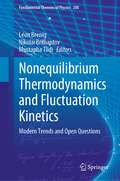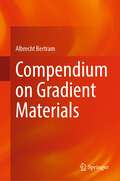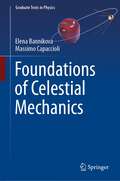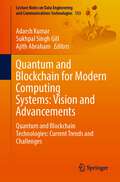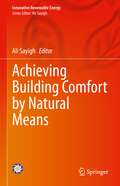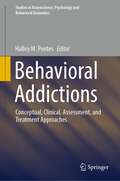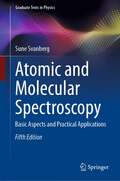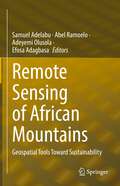- Table View
- List View
Nonequilibrium Thermodynamics and Fluctuation Kinetics: Modern Trends and Open Questions (Fundamental Theories of Physics #208)
by Léon Brenig Nikolai Brilliantov Mustapha TlidiThis book addresses research challenges in the rapidly developing area of nonequilibrium thermodynamics and fluctuation kinetics. This cross-disciplinary field comprises various topics, ranging from fundamental problems of nonequilibrium statistical mechanics and thermodynamics to multiple applications in plasma, fluid mechanics, nonlinear science, systems of dissipative particles, and high-Q resonators. The purpose of this book is to bring together world-leading experts in the above fields to initiate a cross-fertilization among these active research areas. The book is dedicated to and honours the memory of Professor Slava Belyi who passed away unexpectedly on May 20, 2020. He was pioneering the theory of nonequilibrium fluctuations, in particular the application of the Callen-Welton fluctuation-dissipation theorem to nonequilibrium systems and its generalization. This and related problems also feature in the book.
Sensitive Periods of Brain Development and Preventive Interventions (Current Topics in Behavioral Neurosciences #53)
by Susan L. AndersenSensitive periods occur when unique experiences permanently influence brain development either by their presence or absence. This volume covers underlying brain systems and behaviors that are sculpted by the environment in humans and animals in a search for commonalities. The mechanisms involved, the importance of timing in the process, and factors that can change the brain are discussed in this exciting book. Different chapters examine how experience guides the development of cells, circuits, and function using vision, cortical circuits, and cognition as frameworks. Scientific evidence for effective preventative intervention approaches, including diet, exercise, and music, are included to find ways to maximize child and adolescent development. The adverse effects of early brain injury are also included. As sensitive periods are gaining importance in their application in the real-world, novel statistical approaches for human studies are presented and the importance of sensitive periods are covered by examining the juvenile justice system. The book has interdisciplinary appeal and scholars with an interest in brain resiliency or vulnerability will find it of particular interest.
Principles of Light Microscopy: From Basic to Advanced
by Volodymyr Nechyporuk-ZloyThis textbook is an excellent guide to microscopy for students and scientists, who use microscopy as one of their primary research and analysis tool in the laboratory. The book covers key microscopy principles and explains the various techniques such as epifluorescence microscopy, confocal/live cell imaging, SIM/light sheet microscopy, and many more. Easy-to-understand protocols provide helpful guidance for practical implementation in various commercially available imaging systems. The reader is introduced to histology and further be guided through advanced image acquisition, classification and analysis. The book is written by experienced imaging specialists from the UK, other EU countries, the US and Asia, and is based on advanced training courses for master students and PhD students. Readers are not expected to be familiar with imaging and microscopy technologies, but are introduced to the subject step by step. This textbook is indented for biomedical and medical students, as well as scientists and postdocs who want to acquire a thorough knowledge of microscopy, or gain a comprehensive overview of modern microscopy techniques used in various research laboratories and imaging facilities.Chapter 4 is available open access under a Creative Commons Attribution 4.0 International License via link.springer.com.
Compendium on Gradient Materials
by Albrecht BertramThis book offers frameworks for the material modeling of gradient materials both for finite and small deformations within elasticity, plasticity, viscosity, and thermomechanics. The first chapter focuses on balance laws and holds for all gradient materials. The next chapters are dedicated to the material modeling of second and third-order materials under finite deformations. Afterwards the scope is limited to the geometrically linear theory, i.e., to small deformations. The next chapter offers an extension of the concept of internal constraints to gradient materials. The final chapter is dedicated to incompressible viscous gradient fluids with the intention to describe, among other applications, turbulent flows, as already suggested by Saint-Venant in the middle of the 19th century.
The Quadratic Unconstrained Binary Optimization Problem: Theory, Algorithms, and Applications
by Abraham P. PunnenThe quadratic binary optimization problem (QUBO) is a versatile combinatorial optimization model with a variety of applications and rich theoretical properties. Application areas of the model include finance, cluster analysis, traffic management, machine scheduling, VLSI physical design, physics, quantum computing, engineering, and medicine. In addition, various mathematical optimization models can be reformulated as a QUBO, including the resource constrained assignment problem, set partitioning problem, maximum cut problem, quadratic assignment problem, the bipartite unconstrained binary optimization problem, among others.This book presents a systematic development of theory, algorithms, and applications of QUBO. It offers a comprehensive treatment of QUBO from various viewpoints, including a historical introduction along with an in-depth discussion of applications modelling, complexity and polynomially solvable special cases, exact and heuristic algorithms, analysis of approximation algorithms, metaheuristics, polyhedral structure, probabilistic analysis, persistencies, and related topics. Available software for solving QUBO is also introduced, including public domain, commercial, as well as quantum computing based codes.
Peptide Therapeutics: Fundamentals of Design, Development, and Delivery (AAPS Advances in the Pharmaceutical Sciences Series #47)
by Seetharama D. JoisThis book explains how peptide-based drug design works, what steps are needed to develop a peptide-based therapeutic, and challenges in synthesis as well as regulatory issues. It covers the design concept of peptide therapeutics from fundamental principles using structural biology and computational approaches. The chapters are arranged in a linear fashion. A fresh graduate or a scientist who works on small molecules can use this to follow the design and development of peptide therapeutics to use as understanding the basic concepts. Each chapter is written by experts from academia as well as industry. Rather than covering extensive literature, the book provides concepts of design, synthesis, delivery, as well as regulatory affairs and manufacturing of peptides in a systematic way with examples in each case. The book can be used as a reference for a pharmaceutical or biomedical scientist or graduate student who wants to pursue their career in peptide therapeutics. Some chapters will be written as a combination of basic principles and protocol so that scientists can adopt these methods to their research work. The examples provided can be used to perform peptide formulation considerations for the designed peptides. The book has nine chapters, and each chapter can be read as an independent unit on a particular concept.
Theoretical Analyses, Computations, and Experiments of Multiscale Materials: A Tribute to Francesco dell’Isola (Advanced Structured Materials #175)
This book is devoted to the 60th birthday of the Prof. Francesco dell’Isola, who is known for his long-term contribution in the field of multiscale materials. It contains several contributions from researchers in the field, covering theoretical analyses, computational aspects and experiments.
Fundamentals of Strength: Principles, Experiments, and Applications of an Internal State Variable Constitutive Formulation (The Minerals, Metals & Materials Series)
by Paul FollansbeeThis second edition updates and expands on the class-tested first edition text, augmenting discussion of dynamic strain aging and austenitic stainless steels and adding a section on analysis of nickel-base superalloys that shows how the mechanical threshold stress (MTS) model, an internal state variable constitutive formulation, can be used to de-convolute synergistic effects. The new edition retains a clear and rigorous presentation of the theory, mechanistic basis, and application of the MTS model. Students are introduced to critical competencies such as crystal structure, dislocations, thermodynamics of slip, dislocation–obstacle interactions, deformation kinetics, and hardening through dislocation accumulation. The model described in this volume facilitates readers’ understanding of integrated computational materials engineering (ICME), presenting context for the transition between length scales characterizing the mesoscale (mechanistic) and the macroscopic. Presenting readers a model buttressed by detailed examples and applications, the textbook is ideal for students, practitioners, and materials researchers.
Foundations of Celestial Mechanics (Graduate Texts in Physics)
by Elena Bannikova Massimo CapaccioliThis book provides an introduction to classical celestial mechanics. It is based on lectures delivered by the authors over many years at both Padua University (MC) and V.N. Karazin Kharkiv National University (EB). The book aims to provide a mathematical description of the gravitational interaction of celestial bodies. The approach to the problem is purely formal. It allows the authors to write equations of motion and solve them to the greatest degree possible, either exactly or by approximate techniques, when there is no other way. The results obtained provide predictions that can be compared with the observations. Five chapters are supplemented by appendices that review certain mathematical tools, deepen some questions (so as not to interrupt the logic of the mainframe with heavy technicalities), give some examples, and provide an overview of special functions useful here, as well as in many other fields of physics. The authors also present the original investigation of torus potential. This book is aimed at senior undergraduate students of physics or astrophysics, as well as graduate students undertaking a master’s degree or Ph.D.
Quantum and Blockchain for Modern Computing Systems: Quantum and Blockchain Technologies: Current Trends and Challenges (Lecture Notes on Data Engineering and Communications Technologies #133)
by Adarsh Kumar Sukhpal Singh Gill Ajith AbrahamThis book states that blockchain technology provides a secure distributed, peer-to-peer, and decentralized network with advanced cryptography primitives and protocols. The important question that arises in the quantum computing world is to test the existing blockchain networks against quantum attacks and design quantum computing enabled secure blockchain solutions. This book encourages professionals from different fields to provide blockchain and quantum technology-integrated solutions that incorporate low-cost, effective QoS, fast, secure, and futuristic demands. This book has surveyed and proposed approaches that improve quantum computing and cryptography protocols. Quantum computing and quantum science are not just helpful in software but the hardware world as well. To design networks with quantum science, quantum-enabled devices like quantum memories and quantum repeaters can be useful to demonstrate for organizations. For example, designing a single quantum repeater for long-distance quantum communication is useful in reducing the network cost, and ensuring better security levels. This book has introduced the quantum computing and blockchain technology aspects, their integration approaches and future directions.
Innovative Tools and Methods Using BIM for an Efficient Renovation in Buildings (SpringerBriefs in Applied Sciences and Technology)
by Bruno Daniotti Sonia Lupica Spagnolo Alberto Pavan Cecilia Maria BolognesiThis open access book describes a BIM-based toolkit that has been developed according to the latest research activities on building information modelling and semantic interoperability to optimize the building process. It highlights the impacts of using such new tools to fast renovation activities starting from the decision-making and design stages to the construction site management with the possibility to monitor occupants' and owners’ feedback during the realization process. In this process, a framework has been developed and implemented to allow stakeholders involved in a renovation project to efficiently compile, maintain, and add data about (i) building elements, (ii) building services systems, (iii) tenants, operators, and owners of the building, and (iv) current and predicted performance of the building from the various data sources available. The framework applies and specializes the existing practices in the Semantic Web, Linked Data, and ontology domain to the management of renovation projects. It has been designed to be open so that any system which implements the required functions and uses the specified conventions will be able to achieve semantic interoperability with other framework-compliant systems in the renovation domain. Finally, this book represents the validation process of the toolkit that has been held in three demo sites: a social housing building in Italy and two private residential buildings in Poland and Finland. The outcome shows that the toolkit facilitates the renovation process with relevant reductions of time, costs, and energy consumption and that the inhabitants can take advantage of the increase in building performances, quality, and comfort.
The History of Fossils Over Centuries: From Folklore to Science
by Maurizio Forli Andrea GuerriniThis book discusses the history of invertebrate fossil understanding and classification by exploring fossil studies between the 15th and 18th centuries. Before the modern age, the understanding of fossil findings went through several phases. The treatment by philologists, philosophers and historians of natural sciences involved religious, sometimes folkloristic, aspects before scientific ones. This work showcases and assesses these original findings by carrying out a bibliographical, and above all iconographical research, aimed at finding the first printed images of the objects that we now know as fossils. From here, the authors provide an understanding of the true nature of fossils by analyzing them through modern academic viewpoints, and describing each fossil group from a paleontological and taxonomic point of view, retracing their treatment in the course of the centuries.As a point of reference for each fossil group treated, the authors have considered indispensable the use of ancient prints as evidence of the first iconographic sources dedicated to fossils, starting from those in the late fifteenth century, dedicated to the most common groups of invertebrates without neglecting a necessary exception, the ichthyodontolites, fundamental in the discussion in Italy on the interpretation of the organic origin of fossils, and from the end of the sixteenth century to about half of the eighteenth century. The abundant iconographic apparatus used, often unpublished or specially reworked, is essential and functional to the understanding of the various aspects addressed, a visual complement to the text and vice versa, designed and used taking its cue from the need imposed on early scholars to document their discoveries visually. Among the chosen images there is no shortage of original attributions to fossil finds that have been poorly understood or misidentified until now.The English translation of this book from its Italian original manuscript was done with the help of artificial intelligence (machine translation by the service provider DeepL.com). A subsequent human revision of the content was done by the authors.
Climate Change Impact on Groundwater Resources: Human Health Risk Assessment in Arid and Semi-arid Regions
by Balamurugan Panneerselvam Chaitanya Baliram Pande Kirubakaran Muniraj Anand Balasubramanian Nagavinothini RavichandranThis volume discusses climate change impacts on groundwater quality in arid and semi-arid regions, and provides human health risk assessments due to pollution of surface and groundwater. The book presents recent trends in monitoring groundwater management and implementing pollution mitigation strategies, including practices involving remote sensing and GIS techniques, entropy water quality index, weighted arithmetic water quality index, fuzzy logic applications, and improved irrigation methods. The book also outlines hydrological processes in arid and semi-arid regions and hydrochemical properties of surface and groundwater as a necessary background for understanding how pollution impacts groundwater quality and resources, and how geographical modeling of hydrological processes can aid in human health risk assessments. The book is intended for academics, administrators, policymakers, social scientists, and professionals involved in the various aspects of climate change impact on groundwater quality, hydrological process, pollution mitigation strategies, sustainable development, and environmental planning and management.
Achieving Building Comfort by Natural Means (Innovative Renewable Energy)
by Ali SayighAchieving Building Comfort by Natural Means explores examples of green building designs and methods that are currently being used around the world to achieve human comfort in buildings. The operation of buildings accounts for more than 40% of total energy use and is a major source of carbon emissions. It is imperative that this consumption be substantially decreased and that energy needed for building comfort is obtained from renewable and environmentally friendly sources. This book brings together a global group of contributors who look at factors such as location, climate, building materials, energy management, ventilation, thermal environmental conditions, shading, lighting, acoustics, and more that are critical for achieving buildings that are more sustainable.Thermal comfort and climatic potential of ventilative cooling in Italian climates is available open access under a Creative Commons Attribution 4.0 International License via link.springer.com.
Additive Manufacturing: Materials, Functionalities and Applications
by Kun ZhouThis book focuses on the advances of additive manufacturing in the applications of wearable electronics, energy storage, biomedical implants and devices, drug delivery, and technologies for 4D printing, large-scale printing, and ceramics printing. It provides timely insights into the materials, functionalities, and applications of additive manufacturing.
Circular Economy and Waste Valorisation: Theory and Practice from an International Perspective (Industrial Ecology and Environmental Management #2)
by Jingzheng Ren Long ZhangThe authors and editors of this volume state that with the intensive growth of global industrialization and urbanization, the consumption of various resources and materials, such as energy, minerals, and even water, is increasing at an amazing speed, which poses great pressure on material resources. In addition, the massive utilization of materials has led to low efficiency, resulting in great wastes of resources as well as serious environmental pollutions and degradation, which has severely hindered the sustainable development of economy and society. In order to transit to sustainable development, it is necessary to improved resource efficiency, and circular economy and waste valorization are the best alternative ways for achieving this goal. This book aims to provide an in-depth description of circular economy and waste valorization, make assessments for circular economy and waste valorization in different regions and countries and determine the technological pathways and roadmap for achieving circular economy and waste valorization. More specifically: (1) Conceptions and Theories: Concepts and definitions of circular economy and waste valorization and their nexus and contributions to sustainable development. (2) Policy and Practice: Measurement and assessment of performance or sustainability for implementing circular economy and waste valorization. (3) Pathways and Prospects: Identification and prioritization of the barriers, strategies, technologies, and pathways for achieving circular economy and waste valorization. The book systematically and comprehensively introduces the definitions, concepts, framework and nexus of circular economy and waste valorization, analyzes and measures their performance and sustainability and provides the methods for investigating and prioritizing the barriers and strategies and determining the pathways and roadmap for their development.
Polarized Light in Biomedical Imaging and Sensing: Clinical and Preclinical Applications
by Jessica C. Ramella-Roman Tatiana NovikovaThis book focuses on biomedical applications of polarized light, covering instrumentation and modeling specific to the field. This will be the first book, written by leading researchers in the field, to tackle this important topic. Readers will learn the fundamentals of polarized light transport and how to develop instrumentation for clinical and preclinical studies. They will also become familiar with the latest advancement in data analysis and image processing for a variety of medical applications. The book is dedicated specifically to the biomedical community, including scientists, engineers, and physicians working on the development of instrumentation for clinical and preclinical use.Emphasizes biomedical imaging and sensing;Describes new computational approaches with examples;Provides detailed descriptions of novel instrumentation.
Handbook of Human Multitasking
by Andrea Kiesel Leif Johannsen Iring Koch Hermann MüllerThis handbook on human multitasking provides an integrative overview on simultaneous and sequential multitasking and thus combines theorizing on dual task limitations as well as costs related to task switching. In addition to a wide range of empirical findings and their theoretical integration, the editors provide a number of applications of multitasking, like training, interindividual differences and applied research in traffic and health psychology and music expertise.The book is suitable for people interested in multitasking, that is, for researchers and graduate students of cognitive psychology, movement science, sport psychology, cognitive neuroscience, cognitive and neurological rehabilitation, aging sciences, and broader cognitive science.
Handbook of Best Practices in Sustainable Development at University Level (World Sustainability Series)
by Walter Leal Filho Claudio Ruy Portela de VasconcelosThis book gives a special emphasis to state-of-the-art descriptions of approaches, methods, initiatives, and projects from universities, stakeholders, organizations, and civil society across the world, regarding cross-cutting issues in sustainable development.There is a perceived need for mobilizing the various stakeholders when attempting to promote sustainability in higher education and to promote best practices, which may inspire further initiatives. But despite this need, there are a few publications handling this matter in a coherent way. In order to meet the pressing need for publications which may document and disseminate examples of best practice on sustainable development at university level, the “Handbook of Best Practices in Sustainable Development at University Level” is being published.This book is produced by the European School of Sustainability Science and Research (ESSSR), through the Inter-University Sustainable Development Research Programme (IUSDRP) and contains inputs from authors across all geographical regions.The book also discusses examples of initiatives coordinated by universities but involving civil society, the private sector, and public sector (including local, national, and intergovernmental bodies). In particular, it describes practical experiences, partnerships, networks, and training schemes for building capacity aimed at fostering the cause of sustainable development at institutions of higher education.Thanks to its design and the contributions by experts from various areas, it provides a welcome contribution to the literature on sustainable development, and it may inspire further works in this field.
Behavioral Addictions: Conceptual, Clinical, Assessment, and Treatment Approaches (Studies in Neuroscience, Psychology and Behavioral Economics)
by Halley M. PontesThis book provides a holistic evidence-based perspective on conceptual, clinical, assessment, and treatment aspects of key non-substance-based addictive disorders related to: gambling, gaming, social media, smartphone, internet, love, sex, exercise, work, and shopping. Each chapter focuses on a different addictive disorder and is structured in a user-friendly way to enable the reader fast navigation, yet the main aspects of the respective disorders are covered in the necessary depth. All in all, this book offers a timely, self-contained introduction to both key concepts and the latest scientific developments in behavioral addictions. It addresses mental health practitioners, researchers in psychology, neuroscience and communication, and undergraduate and postgraduate students alike.
Atomic and Molecular Spectroscopy: Basic Aspects And Practical Applications (Springer Series On Atomic, Optical, And Plasma Physics Ser. #6)
by Sune SvanbergSelf-Organization as a New Paradigm in Evolutionary Biology: From Theory to Applied Cases in the Tree of Life (Evolutionary Biology – New Perspectives on Its Development #5)
by Anne Dambricourt MalasséThe epistemological synthesis of the various theories of evolution, since the first formulation in 1802 with the transmission of the inherited characters by J.B. Lamarck, shows the need for an alternative synthesis to that of Princeton (1947). This new synthesis integrates the scientific models of self-organization developed during the second half of the 20th century based on the laws of physics, thermodynamics, and mathematics with the emergent evolutionary problematics such as self-organized memory.This book shows, how self-organization is integrated in modern evolutionary biology. It is divided in two parts: The first part pays attention to the modern observations in paleontology and biology, which include major theoreticians of the self-organization (d’Arcy Thompson, Henri Bergson, René Thom, Ilya Prigogine). The second part presents different emergent evolutionary models including the sciences of complexity, the non-linear dynamical systems, fractals, attractors, epigenesis, systemics, and mesology with different examples of the sciences of complexity and self-organization as observed in the human lineage, from both internal (embryogenesis-morphogenesis) and external (mesology) viewpoints.
Antifungal Metabolites of Rhizobacteria for Sustainable Agriculture (Fungal Biology)
by R. Z. Sayyed Anjana Singh Noshin IlyasAntifungal Metabolites of Rhizobacteria for Sustainable Agriculture focuses on plant health in agro-ecosystems of various economically important cash and food crops with a concern to promote sustainable agriculture. They have emerged as a key organic tool for enhancing yields. In a natural environment the interactions between plants and phytopathogenic fungi are complex and survival requires a development of resistance to plant diseases. Diversity of Plant Growth Promoting Rhizobacteria (PGPR) diversity depends on the nature of root exudates and soil conditions that affect their interaction with host plants. Novel strategies, such as, applying bioactive natural products against the pathogenic fungus are required to control disease sustainably. Various classes of secondary metabolites including lipopeptides, macrolides, alkaloids, terpenoids and phenolics from microorganisms and plants strongly suppress fungal growth and can also be effective in controlling plant diseases both in vitro and in vivo. The modes of actions of some potential antifungal secondary metabolites against pathogenic fungus are also discussed.Eco-friendly fungal species and their metabolites are excellent agents used for regulating various fungal and bacterial phytopathogens and may have tremendous potential for other applications, and play a key role in enhancing plant tolerance to stress. Antifungal Metabolites of Rhizobacteria for Sustainable Agriculture also covers bovine-based formulations used for sustainable production and nutritional security through horticultural crops, thereby addressing the problems associated with malnutrition and under-nutrition encountered by small and marginal farmers, as well as by families facing resource constraints. These techniques can also improve breathable air, drinkable water, and consumable foods. This book addresses the need to mitigate the health problems of people via organic crop production and to improve the socio-economic status of farmers (especially in developing countries), and to revitalize agricultural sustainability.
Human Sustainable Cities: Towards the SDGs and Green, Just, Smart and Inclusive Transitions
by Voula MegaThis book argues that accelerating action toward sustainability for and by cities and their inhabitants can make a huge difference to humanity’s endeavor to recover from current crises and build a sustainable future. It sheds light on cutting-edge concepts and actions toward sustainability that can taken by and for cities and with citizens. In this book, author Voula Mega takes the reader on a journey inside and across cities and highlights efforts toward a paradigmatic shift that reconciles human systems with nature. Leadership, education, innovation, trust and citizen empowerment all play a crucial role for the co-invention of a new model that balances human well-being, sustainable prosperity and the future of the planet. Building on robust evidence and inspired by best practices, Human Sustainable Cities offers compelling messages and convincing advice to all stakeholders who are striving to overcome crises, speed up the path toward resilience and preparedness and bounce forward better.
Remote Sensing of African Mountains: Geospatial Tools Toward Sustainability
by Samuel Adelabu Abel Ramoelo Adeyemi Olusola Efosa AdagbasaThis edited volume focuses on the use of remote sensing techniques to assess and monitor mountainous ecosystems in Africa, with a focus on tracking changes related to climate change and human activity. The book is timely, as the interaction of mountain environmental dynamics with conservation and sustainability is an under-researched issue. The chapters in this volume use remotely sensed data to study a variety of topics related to mountains and their ecosystems, including but not limited to vegetation, energy systems, environmental hazards, ecosystem services, diseases, climatic shifts, geological formations and geomorphological dynamics. The ability to monitor, assess and analyze mountainous regions is aided by the availability of remote sensing products such as optical and microwave sensors and low-cost unmanned aerial vehicles (UAVs). The works presented here push the frontier of knowledge on mountain studies and will help shape local, national and global assessments and policies, including efforts toward the achievement of the African Agenda 2063. The book will be of interest to researchers and students in remote sensing, geography, ecology and sustainability, as well as to government organizations and conservation specialists.
